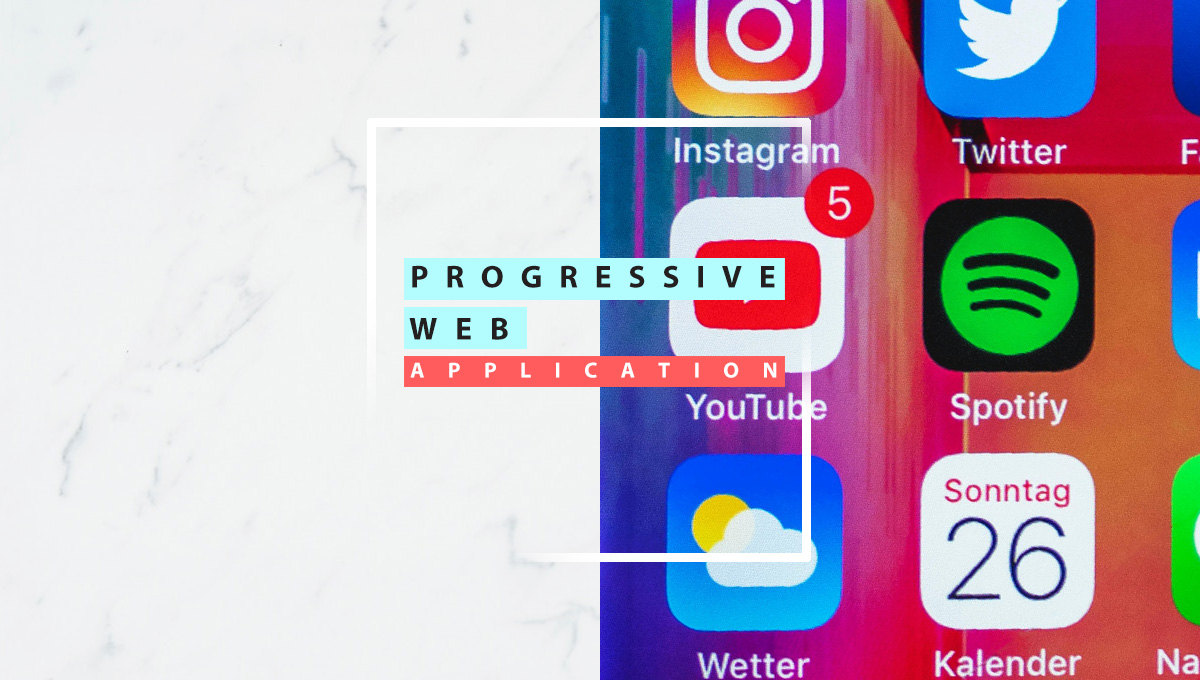Today we have the power to do anything using mobile and apps. Whether we want to buy clothes or want to order a new air conditioner for our home, we can do it quite easily. All we have to do is open that company’s app, browse the products, pick the one we need and confirm our order. All set and done with just a few taps. There are apps for everything from banking to education, retail shopping to investing. You can also access even government services through many apps made by the government. We can do almost everything without taking a foot out of our homes.
But when we look at these apps from the perspective of the business owners, then some not-so-good things come forward. Managing apps is a cumbersome job and is quite expensive for small businesses.

So, how do they manage?
Well, it’s quite simple. The advanced technology of the current time comes to the rescue. It combines the features and benefits of a mobile app with the technology used for web development to build a cost-effective app for their business. It is Progressive Web Application
Let’s discuss in deep what Progressive Web Application is
What is a Progressive Web Application
Well known web technologies like HTML, CSS and JavaScript are used to develop a Progressive Web Application. But this doesn’t mean that Progressive Web Applications lack functionalities or are substandard to native apps.
Progressive Web Application is an application software delivered through the web. It works on any device, be it a mobile or a desktop. The only prerequisite is that the platform has a compliant browser. It is a website that behaves like an app. These are developed so that the end user gets all the functionalities of a native app without going to an app store to download it locally or purchase it. A user can locate a Progressive Web Application using search engines and use it.
Because of Progressive Web Applications, online retailers no longer have to create separate native apps for each smartphone OS. Frances Berriman, a designer, and Alex Russell, a Google Chrome programmer, came up with the term “progressive web apps” in 2015.
They have features like push notifications and can be used without the Internet. Users are three times more likely to reopen a mobile app than a website, and applications that use push notifications can increase retention by as much as three times.
They are developed with up-to-date application programming interfaces, or APIs, which facilitate the provision of additional features, dependability, and portability. Building a Progressive Web Application involves using the huge web ecosystem consisting of plugins and community. Developing a Progressive Web Application is quite easy in comparison to native app development.
You May be Interested : How To Make A WordPress Website?
Many Big Companies are Using Progressive Web Applications Today
Since they have such great benefits, many big companies have incorporated them too, because they work on every mobile device with the same ease, be it an android or iOS. Twitter, Pinterest, Uber, TikTok, and Spotify are a few examples of well-known companies that use Progressive Web Applications.
To reach the widest possible target audience with a single set of code, progressive web apps (PWAs) take advantage of the latest application programming interfaces (APIs) in their development and refinement.
A common feature of this product is the ability to be placed directly on your home screen, the capacity to keep working offline from where you left them, and the delivery of an experience and set of features that are competitive with those of the corresponding native apps.
Developing Progressive Web Applications requires keeping some expectations in mind to develop a worthy application.
Let’s discuss some prime characteristics of a good Progressive Web Application
According to the most recent data from 2022, we spend an average of 3 hours and 43 minutes a day on our phones. All of these features are needed to have maximum interaction with the user.
Responsiveness
People use different devices with different screen sizes to surf the Internet. So, developing a Progressive Web Application that is responsive, which means that it adjusts itself to the screen size on which it is used, is a must. Responsiveness is the prime characteristic of a good Progressive Web Application. Your app’s content must be accessible regardless of the size of the user’s screen.
Discoverable
PWA is discoverable from search results. This is what puts it ahead of the native app since one can use search engines to find progressive web apps, whereas searching for a native app leads you to the page where you need to install the app and not to the app directly . So, a Progressive Web Application is very much discoverable as it is nothing but a converted website. This will enable you to have extra traffic to your app
Installation
According to research, user tends to engage more with the installed apps than with your website. A Progressive Web App (PWA) product has the same feel, functionality, and engagement as a traditional app.
Re-engageable
Mobile app users tend to reuse the app after installation, and these Progressive Web Applications are designed with the same purpose in mind to re-engage the user. They achieve this using push notifications. In 2017, Twitter came out with Twitter Lite, a Progressive Web Application version of the official Android and iOS apps. Twitter says that Twitter Lite only took up 1-3% of the space that the native apps did. Twitter defaulted all of its website users to Twitter Lite in July 2019. On June 1, 2020, Twitter turned off the old version of its website, leaving only the progressive web app version.
Starbucks has a Progressive Web Application that is 99.84% smaller than its iOS app, which does the same thing. Starbucks doubled the number of online orders after putting in place its Progressive Web Application, and desktop users placed orders at about the same rate as app users.
Connectivity Independent
They should be able to work if the network is not good and even offline. This feature makes them quite unique. Rather than sending users to a generic offline page, keeping them engaged in your app even when they’re not connected to the Internet ensures a more consistent experience.
Progressive
A progressive web app can be accessed from any browser and device and adapts to the user’s environment by making use of the browser’s and device’s capabilities.
Safe
The app protects its users by employing a secure HTTPS connection and other measures. A progressive web app must be hosted over HTTPS to prevent man-in-the-middle attacks, as the user experience is more personal, and all network requests can be intercepted through service workers. Progressive web apps must be served via HTTPS to ensure user privacy, security, and content authenticity.
You May Like: How to Choose the Best Domain Name
Linkable
The app should be linkable to a Specific URL, so there is no need for any App store or complex installation process. One can share and launch a progressive web app using that specific URL.
Differences between a Progressive Web Application and a Native App
The cost involved in the development
Developing native apps require expertise in any programming language, and you have to build different versions for different mobile operating systems like Android and iOS. Further, you will need more resources to maintain and update the app, which could be costly, whereas Progressive Web Application is built using programming languages like HTML, CSS, and JavaScript, which are quite easier to learn and widely used in the field of website development. I am not saying that expertise is not required, but these languages are known to web developers. Moreover, you don’t have to build it from scratch; you have to just configure your current website to convert it into an app. You don’t have to write different codes for different devices. Only one single codebase for all devices.
These things make Progressive Web Applications a lot cheaper to develop than native apps.
Discoverability
It is one of the most useful features of a Progressive Web Application. Progressive Web Application is just like websites; the search engine indexes them. A user can use a search engine to search a Progressive Web Application. For native apps, you have to go to the app store to find the app and download it; search engines cannot index them.
According to HubSpot, 93% of users use search engines to look out for anything on the Internet. This data is quite beneficial for Progressive Web Applications. It helps eliminate intermediaries like AppStore, Google Play, and helps Progressive Web Applications to reach out to users directly.
Safety
Today every site requires an SSL certificate to run. SSL certification adds an extra security layer and makes sites invulnerable to cyberattacks. Progressive Web Application is nothing but websites converted into apps, so they are secure as they run HTTPS. These protocols ensure the safe data exchange between the user and the server without any security breach.
For native apps, you must ensure too many safety measures like multifactor verification and others.
Installation and Download
You can download native apps through app stores. It requires multiple steps while installing, too. User need to review and grant too many permissions. At the same time, Progressive Web Application can be bookmarked in the browser and added to the home screen, which makes downloading and installing very convenient. Just a few taps and everything is done—no need to scrutinize the permissions and grant them carefully.
According to research, an app loses about 20% of its users for every touchpoint between the initial discovery of the app and the user’s first use of the app. To use an app, a user must locate it in the app store, download and install it on their device. A user will not have to go through the hassle of downloading and installing your program before using it if it is a progressive web app.
Benefits of Progressive Web Applications
Recently most companies are switching to Progressive Web Applications. Why? Because there are not only easy and cheap to develop, but they provide great engagement with users.
- They are responsive and work on any device of any screen size.
- They use a single codebase for all the operating systems. There is no need to write code for every operating system.
- They work offline too. Whether you have an active internet connection or not, you can still use them.
- Developers use standard web technologies like HTML, CSS, and JavaScript to build progressive web apps.
- They give the feel of native apps.
Not only this they have many other benefits too
- They are fast and very lightweight. They use minimal storage on your device. Speed is important if you want people to use your app. The chance that a user will leave your site goes up by 123% when the time it takes to load a page goes from one second to ten seconds.
- They are discoverable through search engines. 2540 new apps are released per day on average. You can avoid the crowds by using a Progressive Web Application that is accessible from Google Search. There is no need to dig through the piles of apps popping up daily in the sea of apps on the app stores.
- Instant Update is one of the most important features of a Progressive Web Application. Update deployment in app marketplaces is a time-consuming process. Every change requires a platform upload, followed by a review. Generally, it is easy to see what standards must be satisfied, but in the case of Apple, things could get complicated. There can be no glitches or broken links inside the software, and its screenshots must be accurate. Whereas Updating Progressive Web Application is an independent process, you don’t have to visit the app store to update them.
- Installation is easy
- Maintenance cost is low.
What do we need to Develop A Progressive Web Application?
Developing Progressive Web Application only requires a few things. A few things and you are all set to develop into a Progressive Web Application
Tools Required
The best-known technology to develop Progressive Web Application is AngularJS, ReactJs, Polymer, Webpack Module Bundler, ScandiPWA, PWABuilder and Ionic. There are other great alternatives but the ones listed above are vastly used.
HTTPS
You will Definity need a server with HTTPS; this ensures that there is no security breach and everything is secure. Because network requests are vulnerable to man-in-the-middle (MiTM) attacks, the app should be served via HTTPS.
You may Love to Read: How To Make Money Online
Application Shell
Heavily caching the bare minimum of HTML, CSS, and JS to load the basic UI of the website before retrieving the rest via an API is a key component of the application shell paradigm.
Since the majority of the page is stored in cache, the application shell renders instantly on subsequent visits. By eliminating several downloads of static content, it also helps conserve data.
It creates a positive first impression as soon as the app starts up. Simply put, this is your app’s first impression on the user.
Service workers
This is a foundational technology for Progressive Web Applications. It runs in the background, separate from the webpage. A service worker has short lifetime and it is done intentionally. It works only when it gets some event and runs as long as it is needed. They have very limited set of APIs in comparison to JavaScript.
They help your app function without an internet connection by utilizing sophisticated caching and running operations in the background. Service employees can still accomplish their duties if your Progressive Web Application is not active.
Some other functions associated with Service Workers include:
- Sending push notification
- Badging icons
- Running background fetch tasks
Manifest file
Manifest file is a JSON file created using a generator. Your Progressive Web Application’s appearance and behaviour are specified in this file. You get to choose everything from the name of your Progressive Web Application to its description, symbol, and colour scheme.
Top Progressive Web Applications
PWA technology competes with native frameworks because users don’t want to spend time or storage space on installing an app. If the site works well, they will still use it on their phones. The following case studies show that progressive web apps can be more effective than their native counterparts:
1. Adidas
In 2018, a study of the Top 1000 websites in the UK marked Adidas’s store as not doing well enough. The brand released a PWA front in the same year to reach mobile users who don’t have their app. In their new digital strategy, they used pop-ups early on in the buying process to make it easier for users to sign up. The year of the launch was one of the best for Adidas in recent years.
After PWA launch:
- 36% of the world’s income went up in 2018, the year the PWA came out.
- First Contentful Paint took only 2.1 seconds to happen.
- In 2021, the net income from continuing operations grew by 230% from the previous year.
2. Spotify
The purpose of this PWA release was to attract new users to sign up for the free version before upgrading to premium. They didn’t even need to click the link because its ability to send or embed an interactive playlist was the talk of the town after the app’s revamp.
As a result of the rollout, Spotify’s free-to-paid conversion supposedly increased from 26.6% in 2015 to a record 46% in 2019, and then skyrocketed to a stunning 58.4% in 2021.
After the 2019 release of the Spotify PWA:
- There was 30% increase of regular users.
- There was a 45% increase in desktop users.
- Increase of 40% average listening time each month on average
3. Telegram
There are currently 700 million active users of Telegram, a cross-platform instant messaging platform that was released in 2013. It was one of the five most popular apps in the world in 2022. Users can access their accounts from their mobile devices as well as their desktop computers because of the platform’s progressive web app (PWA) version.
After PWA Launch
- The retention rate put increased by 50%.
- Increases of 40% each year in total users
- +175% in monthly active users
- +50% in average sessions per user
4. Eleganza
The owners of the Eleganza clothing store wanted to switch to a newer version of the Magento e-commerce engine, but they also wanted to cut down on loading times and server crashes. In three months, Eleganza built a PWA model with a Magento 2 framework that was made stronger. Since most of the page’s resources are loaded on the client side, the store’s uptime is more stable and the brand saved money on server costs.
After PWA launch:
- The server’s response speed jumped to 372%.
- Page loads were 23% faster on average.
- 76% more pages were viewed per session.
5. BMW
The BMW progressive web app was made to deliver a lot of articles, podcasts, and stories through a website with a classy look that matches the style of the automaker.
On a mobile phone, the user can swipe through immersive content that is shown in “loops” that make it look like the choices never end. Thanks to a well-thought-out PWA reading experience, more people looking for a new car became interested in BWM.
After PWA launch:
- 50% more people signed up.
- On average, pages load four times faster, and four times as many people visit BMW sales pages.
- New SEO optimization made 49% more people visit the site.
Wrapping It up
Progressive Web Applications are very new to the business and have not been completely leveraged, so they might be a useful addition to your arsenal.
Incorporating Progressive Web Applications into your product strategy with up-to-date technology and the appropriate tools can boost sales and revenue for your business or venture. They have several advantages, such as being fast, having the capacity to operate even when offline, and functioning just like regular native apps. With this, you can provide your users with a fantastic experience that will keep them coming back for more. PWA is the future in web development.


